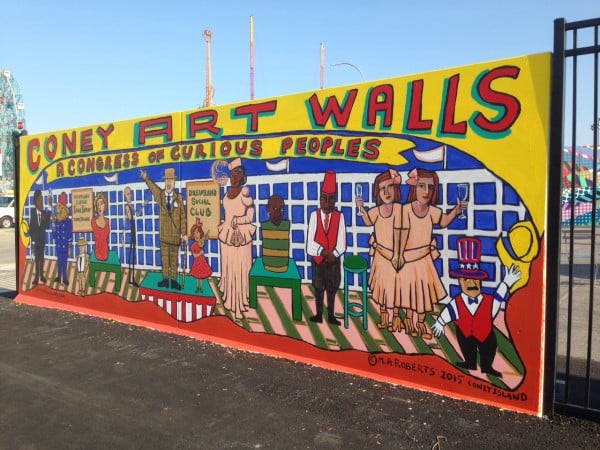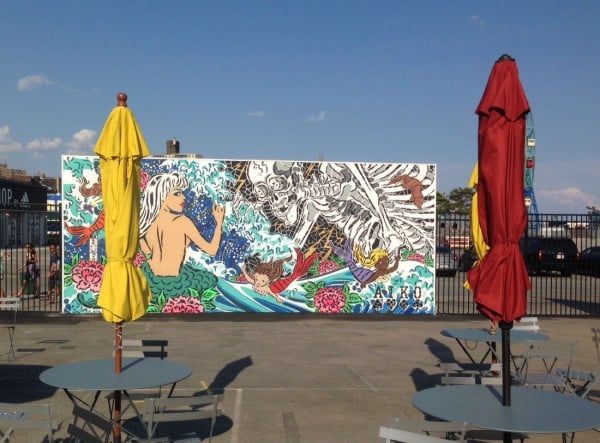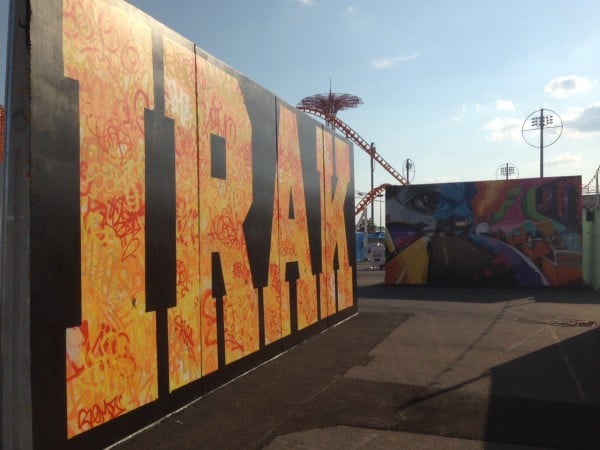Art & Exhibitions
Jeffrey Deitch’s “Coney Art Walls” Exploits Artists for Real Estate Ploy
Neglected urban squalor is tarted up as fun loving Bohoville.

Neglected urban squalor is tarted up as fun loving Bohoville.

Christian Viveros-Fauné


Lady Aiko’s wall.
Photo: Christian Viveros-Faune
Gentrification in New York City used to be about how close you were to downtown Manhattan, but no more. Today, Coney Island—the birthplace of the roller coaster and one of New York’s poorest and farthest flung neighborhoods—has succumbed to the same cycle of gentrification that Disneyfied Times Square and turned Williamsburg into a mecca for “luxury loft living.”
Art, once again, is being used to gussy up the results. This time, it’s courtesy of former dealer and ex-MOCA LA Director Jeffrey Deitch, the property developer Thor Equities, and their bland summertime display of street art. Fittingly, the venture is timidly titled “Coney Art Walls.”
To call “Coney Art Walls” an art exhibition is to commit what philosopher Gilbert Ryle would have termed a category mistake—a semantic error where things belonging to one category are presented as if they correspond to a different order of things. Though Thor Equities and Deitch have erected 25 concrete slabs to serve as temporary walls for murals by more than a dozen artists, their collaboration resembles little more than a real estate marketing ploy.
Ditto for the art on view. Uniformly colorful murals that individually deploy some of street art’s standard motifs—bright hues, stencils, and graphic punch—but engage in neither activism nor neighborhood politics, the Walls constitute perfect PR for gentrification’s nasty middle passage. That’s the part where neglected urban squalor is tarted up as fun-loving Bohoville.
Located at 1320 Bowery Street, on one of Thor Equities’ vacant lots that straddle the boardwalk in the shadow of the defunct Parachute Jump, “Coney Art Walls” shares real estate with a more established youth-oriented entertainment complex—Smorgasburg, a business that provides overpriced craft beer and artisanal foodstuffs for folks of remarkably similar ethnic and socioeconomic backgrounds.

Marie Roberts’s wall.
Photo: Christian Viveros-Faune.
In Coney Island, Smorgasburg holds court from twelve shipping containers painted in designer hues such as daffodil, mint, and peach. The nearby café tables, umbrellas, and signs that read “alcohol must remain within this area” indicate the obvious—food and drink are the showcase of this “pop-up summer village.”But what about the murals? Same as at any regular restaurant or bar, the art here immediately takes on the deadening tones of muzak inside this Hipster Potemkin Village.
Unlike Deitch’s actual 2011 “Art in the Streets” exhibition at MOCA LA and more like the “Wynwood Walls” camouflage he organized for developer Tony Goldman during Art Basel in Miami Beach 2009, “Coney Art Walls” is a project devoted principally to further the XL business plans of Thor Equities owner Joseph Sitt; a man whose company has been referred to by one Huffington Post blogger as “Satan’s real estate division.”
A bizarre boondoggle that New York Magazine declared an “incredibly bold, audaciously cheesy, jaw-droppingly Vegasified, billion-dollar glam-rock makeover of Coney Island,” Sitt’s garish project involves transforming Coney Island’s strip into a full-fledged resort resembling the Bahamas’ Atlantis, complete with indoor water parks and tourist-toting blimps.
For this purpose, Thor Equities has hoovered up acres of prime Coney Island waterfront. A mogul with the heart of a slumlord, Sitt also imposed his vision last year by piling up loads of trash on these same lots—chiefly to drive out competing operators and property owners.
Like all such projects, Thor Equities’ speculative and often underhanded practices urgently demand a cultural makeover. Cue the freelancing Deitch, who despite his colossal failures in Los Angeles is still hailed by the New York Times as an “itinerant showman and dealmaker.”

IRAK’s wall.
Photo: Christian Viveros-Faune.
Deitch, in turn, conscripted street artists like Lady Pink, Daze, Lee Quiñones, Swoon, and Mister Cartoon to give Sitt’s urban redevelopment dog an arty facelift. The results are, in a phrase, joyless, dreary, and dispiriting. Not only are the murals in “Coney Art Walls” homogenous, they prove virtually interchangeable.
As of my visit last week—where I counted 14 finished and three unfinished walls—nearly every mural provided variations on the same type of tame wall art: fake vandalism, ersatz bluster, and vapid cheer. With the exception of Skewville’s monstrous blue and yellow boombox—made from plywood, storm fencing, and safety orange netting—the rest of the stuff on view would also make perfect visuals for Grand Theft Auto V. (See Nine Artists File Federal Lawsuit Against Owner of 5Pointz Property.)
Which leads us to an important point about the use of street art for what is, in essence, a campaign to benefit the interests of a sketchy landlord. It’s one thing for urban artists to seek opportunities with mainstream advertising, but quite another to shill for sketchy property owners in poor neighborhoods for negligible returns.
Speaking about the artists in “Coney Art Walls,” Sitt told NY1, “We’re supplying all of the materials and the canvases and everything to make this happen, but this is not a for-profit venture for them.”
Seeing as the population of Coney Island is the second poorest in the borough according to Crain’s, one also naturally wonders how many locals will be enticed by Deitch’s vapidly flashy murals and Smorgasburg’s $19 lobster rolls. The ironies stack up like biodegradable espresso cups.
The ideals of visual cool and sustainability have rarely appeared more conventionally bourgeois than when uprooted from Brooklyn Heights’s and Park Slope’s tree-lined brownstones and plopped down in a needy zip code like Coney Island’s.
“Gentrification,” says the historian and activist Sarah Schulman, “was not caused by individuals; it was a process of city policy” that swapped low-income housing for tax incentives for luxury developers like Sitt. Just as importantly in Schulman’s telling, the struggle over real estate is only the most obvious side of the story.
Its more pernicious B-side is what she has brilliantly termed “the gentrification of the mind”—a gradual closing down of options in thought, politics, culture and, of course, visual art. Few instances of art world shilling exemplify this more than the depressing summertime circus that is Joseph Sitt’s and Jeffrey Deitch’s “Coney Art Walls.”